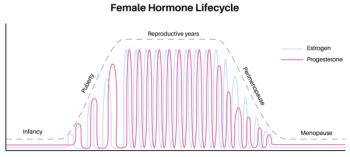
Weight Cycling Ups Risk for Heart Failure by 50%, Other Metabolic Diseases by Up to 30%: New Data
Weight cycling significantly raises heart failure and metabolic disease risks, independent of baseline overweight, underscoring the importance of stable weight strategies.
Weight cycling—repeated episodes of weight loss and regain—significantly increases the risk of developing heart failure by more than 50% (HR 1.54; 95% CI 1.31-1.82), according to new research published in the most recent issue of the journal Obesity.
The “yo-yo” pattern of change in body mass index (BMI) also raises the risk of metabolic diseases including obstructive sleep apnea (OSA), metabolic dysfunction-associated steatotic liver disease (MASLD), and type 2 diabetes (T2D) by nearly 30% compared to maintaining stable weight, authors of the large retrospective cohort study reported.
The findings challenge conventional thinking about weight management, investigators said, by demonstrating that the elevated risk for disease occurred independent of high baseline body mass index (BMI), which remained similar across all weight trajectory groups.
The researchers, from Vanderbilt University Medical Center, analyzed electronic health records from 83,261 adults treated between 1997 and 2020 to investigate how different patterns of weight change affect cardiometabolic disease risk.
“A remaining question, highly relevant to current clinical practice paradigms, is whether having bouts of weight loss and regain is a stronger predictor of poor cardiometabolic health than having chronically high body mass or experiencing weight gain over a prolonged period of time,” Heidi Silver, PhD, RD, director of the Nutrition and Diet Assessment Core at Vanderbilt University Medical Center, and colleagues wrote.1 “No prior study using data from a large regional comprehensive health system has compared longitudinal relationships between weight trajectory category (weight stable, weight gainer, weight loser, or weight cycler) to the variety of commonly occurring cardiometabolic disease states among persons with similar high baseline BMI.”1
Weight cycling affects an estimated 27-50% of the adult population, driven in part by the difficulty of maintaining weight loss—only 20% to 56% of adults sustain clinically significant weight loss over 2-5 years.2,3 Even with newer incretin mimetics showing substantial weight loss efficacy, fewer than 50% of adults continue treatment beyond one year, potentially setting the stage for weight cycling episodes.4
Silver and colleagues used a landmark approach to minimize bias in time-to-event analysis, following patients for a median of 5.2 years after an initial 5-year observation period. They categorized participants into four weight trajectory groups based on clinically significant 5% weight changes: weight cyclers (54.4% of participants), weight gainers (22.9%), weight losers (13.2%), and weight stable individuals (9.5%).1
FINDINGS
The study population was 60.3% women with a median age of 50.5 years and median BMI of 27.6 kg/m². Silver et al reported that weight cycling prevalence reached 50% in men and 57% in women. Despite similar baseline BMI across groups, weight cyclers showed higher rates of prescribed medications for hypertension, dyslipidemia, and diabetes, suggesting greater underlying cardiometabolic disease burden, the authors noted.1
Using multivariate Cox proportional hazards regression models adjusted for age, sex, race, ethnicity, height, baseline BMI, smoking status, and medications, the researchers found weight cycling conferred the highest risk for heart failure among all weight trajectories. Notably, weight gain and weight loss also increased heart failure risk (HR 1.29; 95% CI 1.08-1.55 and HR 1.32; 95% CI 1.10-1.58, respectively), suggesting bidirectional relationships between weight change and cardiac dysfunction.1
In adjusted analyses, weight cycling was significantly associated with greater than 50% increased risk for heart failure (hazard ratio [HR], 1.54; 95% CI, 1.31-1.82) as well as almost 30% increased risk for obstructive sleep apnea (HR, 1.28; 95% CI, 1.15-1.42), MASLD (HR, 1.28; 95% CI, 1.08-1.51), and type 2 diabetes (HR, 1.23; 95% CI, 1.10-1.38) compared to being weight stable.1 Investigators noted weight gain was also significantly associated with increased risks of obstructive sleep apnea, MASLD, type 2 diabetes, hypertension, and hyperlipidemia. In contrast, sustained weight loss provided protective effects, reducing hypertension risk by 11% compared to weight stability.
Among the study’s limitations, Silver and colleagues suggest potential bias from intentional vs unintentional weight loss, undetectable from electronic health records, and the finding that participants with more recorded weights showed higher disease incidence, possibly reflecting either greater illness or more health-seeking behavior, authors suggested. The study also lacked data on crucial lifestyle factors such as diet, physical activity, and socioeconomic status.
“The present findings support the promotion of either weight stability at higher BMI or weight loss if able to be maintained as critical strategies to prevent the incidence of a variety of cardiometabolic diseases. Such a paradigm shift would align with achieving more personalized care providing targeted interventions to the people who would most benefit,” investigators concluded.1 “Furthermore, greater public health efforts are required to publicize the importance of minimizing changes in body weight over time when weight loss cannot be maintained.”
References
- Swartz AZ, Wood K, Farber-Eger E, Petty A, Silver HJ. Weight trajectory impacts risk for ten distinct cardiometabolic diseases. J Clin Endocrinol Metab. doi:10.1210/clinem/dgaf348
2. Lean MEJ, Leslie WS, Barnes AC, et al. Durability of a primary care-led weight-management 24 intervention for remission of type 2 diabetes: 2-year results of the DiRECT open-label, cluster25 randomised trial. Lancet Diabetes Endocrinol. 2019;7(5):344-355. doi:10.1016/S2213- 26 8587(19)30068-3
3. Fildes A, Charlton J, Rudisill C, Littlejohns P, Prevost AT, Gulliford MC. Probability of an Obese 2 Person Attaining Normal Body Weight: Cohort Study Using Electronic Health Records. Am J 3 Public Health. 2015;105(9):e54-e59. doi:10.2105/AJPH.2015.302773
4. Rodriguez PJ, Zhang V, Gratzl S, et al. Discontinuation and Reinitiation of Dual-Labeled GLP-1 5 Receptor Agonists Among US Adults With Overweight or Obesity. JAMA Netw Open. 2025;8(1):e2457349. doi:10.1001/JAMANETWORKOPEN.2024.57349
Newsletter
Enhance your clinical practice with the Patient Care newsletter, offering the latest evidence-based guidelines, diagnostic insights, and treatment strategies for primary care physicians.



























































































































































































































































































